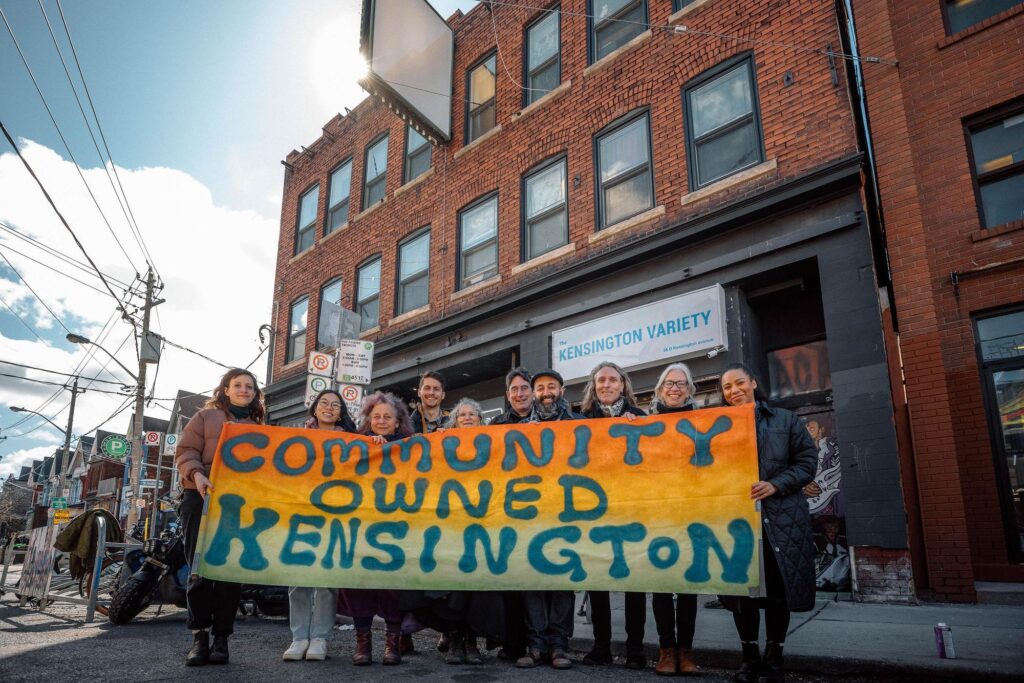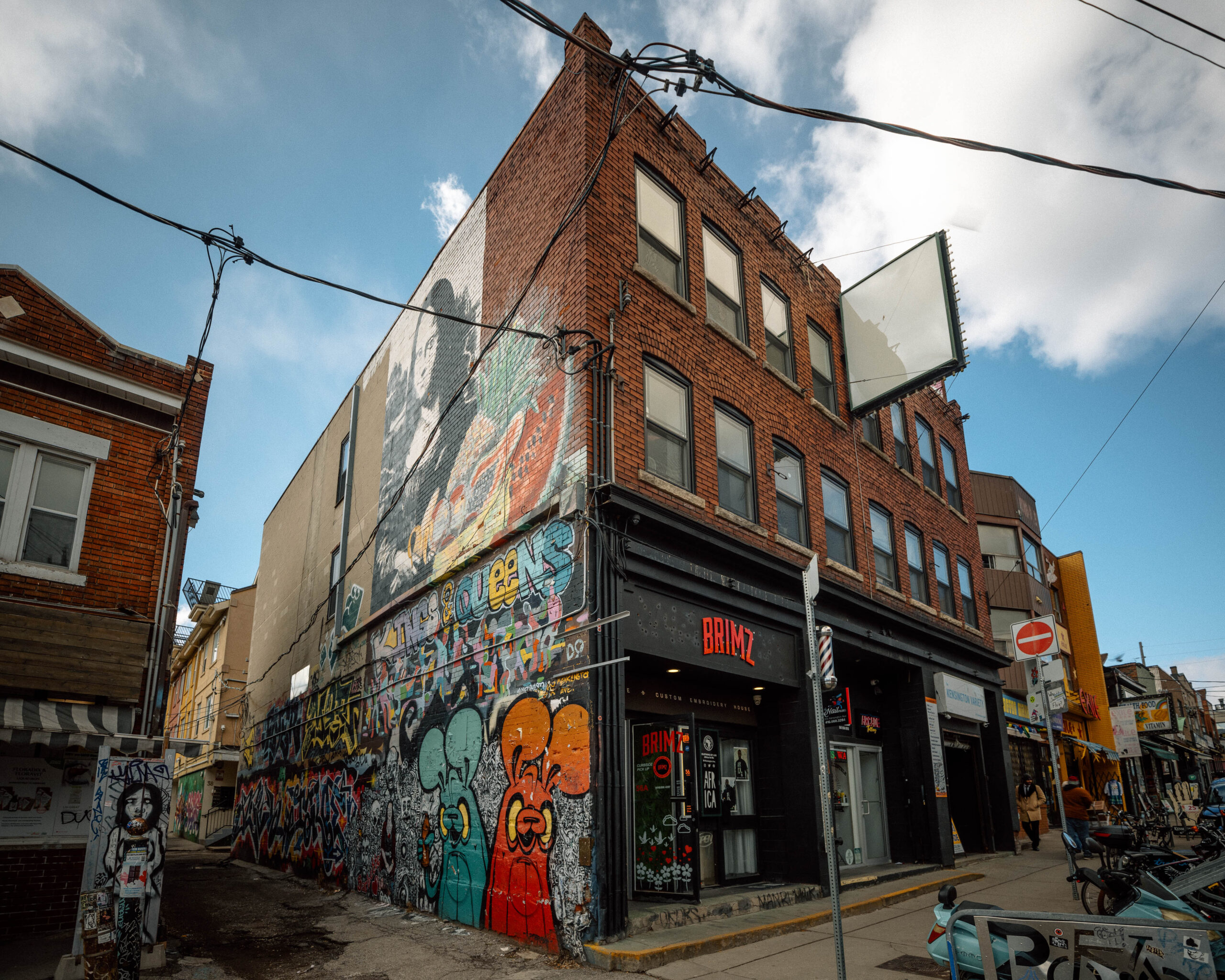A Fight for Home in Kensington Market
For tenants in Toronto’s Kensington Market, the fight for housing isn’t just about affordability—it’s about survival. When corporate landlords moved in with the intention of pushing long-term residents out, the community banded together to fight back. Greg Harrington, a tenant of 16 years, was among those facing eviction.
“They handed us our eviction notice within the first year of purchasing it—on New Year’s Day, early in the morning,” Greg recalls. “They did no maintenance, no cleaning, and all they wanted to do was get us out.”
Thanks to community organizing efforts, a large forgivable loan from the City of Toronto, and the support of the Balanced Supply of Housing, the Kensington Market Community Land Trust (KMCLT) stepped in to secure the building, keeping Greg and his neighbours in their homes. The ‘Mona Lisa’ building, at 54/56 Kensington Avenue, lies in the heart of the Kensington Market neighbourhood. For the area, it’s a typical mixed-use structure, comprising five commercial units at or below grade and 12 residential apartments on the upper two floors.
Kevin Barrett, KMCLT’s board Co-Chair, emphasized how crucial BSH’s support was in turning this vision into reality. “There’s no chance that we would have gotten through that process [of acquiring our first building] without the very concrete support of money and access to the right people,” he explained. This early support laid the groundwork for KMCLT to establish itself as a key player in preserving affordable housing in Toronto’s historic neighbourhood of Kensington Market.
With support from Kensington Market Community Land Trust (KMCLT) and local organizations, Greg and his neighbours were able to keep their homes. Today, the building is permanently off the speculative market, ensuring that long-standing community members can continue to live with security and dignity.
The Battle Against Displacement
The building Greg lives in was family-owned until it fell into the hands of a corporate investor that neglected maintenance and pushed tenants toward eviction. Tenants saw essential maintenance neglected, and some were even offered buyouts to leave. As Dominique Russell, KMCLT Co-Director put it,
“Gentrification is a real estate problem; it’s the perfect functioning of the capitalist real estate market that ultimately excludes the community. We have to put a stick in the spoke of that system.”
“The first thing they did when they moved into the building was remove some of the commercial businesses down there… and open illegal drug dispensaries,” Greg explains. “They wanted to be an Airbnb. They told us, ‘You all have to leave.’ Then they changed their tune—‘Oh no, we need to renovate, and you can move back in at a higher rent.’”
Knowing their rights and with the support of groups like Friends of Kensington Market (the precursor to KMCLT) and Kensington-Bellwoods Community Legal Services, tenants resisted eviction attempts. The pressure worked—the eviction notices were rescinded.

“We weren’t going to leave without a fight,” says Greg. “I wasn’t going to be bullied out of my apartment by somebody who’d never even been in my neighbourhood.”
Pictured: KMCLT activists stand in front of the ‘Mona Lisa’ building, with Kevin Barrett and Dominique Russell third and second to the right, respectively.
A Turning Point: Community Ownership
When KMCLT acquired the building, everything changed:
“Now we get maintenance issues dealt with,” Greg shares. “Some people had countertops that were just leaking and falling apart. [KMCLT] actually did the maintenance that had been needed for decades.”
The impact went beyond physical repairs—tenants could finally breathe. Greg, who had been facing eviction while preparing for heart surgery, describes the relief: “Just knowing that they weren’t getting us out… everybody in the building kind of had a breath and a chance to relax.”

Describing the mass gentrification of the neighbourhood, Russell said, “it’s as if no one is responsible… but that crisis has to do with the extraction of the good that we experience on a daily basis, the monetizing of every aspect of human life to the benefit of the few. The antidote to that is creating communities of care.”
This is exactly how KMCLT has approached the management of the Mona Lisa building.
Pictured: Dominique Russell
The Power of Community and Collective Action
Greg’s story is one of many that highlight the broader impact of the Community Land Trust model. At the Balanced Supply of Housing, researchers are looking at the role that Community Land Trusts, like KMCLT, can play to protect affordable housing and strengthen security of tenure. According to BSH’s partner, the Canadian Network of Community Land Trusts (CNCLT), CLTs “acquire and steward land for the benefit of local communities”. By taking properties out of the speculative market, these initiatives preserve affordability and protect tenants from predatory landlords.
To learn more about CLTs, read our CLT Definitions report and check out our other policy papers.
“I love my community. People care for each other. Everybody knows everybody. This isn’t a place where you live for a few years. Most [Kensington] market people will spend their entire life here.”
The stability provided by the land trust means Greg and his neighbours can continue to be part of this vibrant community for years to come.
Lessons for the Future
The success of Kensington Market CLT underscores the importance of tenant organizing, legal support, and community-led housing solutions. While KMCLT is looking forward, it is rooted in reconnecting with more holistic systems. As Barrett puts it: “We now know that the old-school economics notion of “supply and demand” doesn’t apply to housing. Financialization is a new, different, and utterly destructive force within the housing “market”, and we need to think about things differently. I hope we can learn from our First Nations sisters and brothers about the importance of land and our relationship to the it and see that ownership and control of land needs to be rooted in our community and our relationships.“
“My dream is that we’re able to continue to grow and to own enough land that we can start to play the game the way the “big boys” do: leveraging our portfolio to keep growing, acquiring more & more property, but in a way that benefits the neighbourhood. We want to grow community ownership of the land in the neighbourhood; we want to trap those resources in the community, not see them continually sucked away.”
For tenants facing similar challenges with speculative investors, Greg offers one message: “Organize and find organizations that will stand with you… Greed is not a reason for homelessness.”
Building Momentum
Just last month, KMCLT successfully acquired its second building with two residential units and one commercial space at 380 Spadina Ave. Thanks to fundraising through its Kensington Community Bond Campaign, they raised $1million in under 8 months from 170 community investors. In addition to $400,000 from the City of Toronto, the CLT was able to finance the purchase without taking out a mortgage from the bank—meaning the new property is completely community-financed and community-owned. Not only is this a win for the current tenants, who will see a reduction in their rent, but also for the community at large as this model continues to see success and growth.
The KMCLT is proof that community-driven solutions work. Russell sees a larger vision:
“I see the future of the organization not just in acquiring [land] and making a shift in the real estate market, but to actually shift the whole way we treat one another.”
A Call to Action
KMCLT’s success is a testament to what’s possible when communities come together to protect their homes. At the University of British Columbia’s Balanced Supply of Housing, a Canada Mortgage and Housing Corporation (CMHC) and Social Science and Humanities Research Council (SSHRC)-funded research node, researchers are working to support alternative housing models like KMCLT’s. To support similar initiatives, learn more about community land trusts, get involved in housing advocacy in your city, or visit BSH’s community partner, the Canadian Network of Community Land Trusts for more on CLTs across the country.
As Greg puts it:
“You don’t buy a neighbourhood, you make a neighbourhood.”
Pictured: Greg Harrington and his dog.

The Balanced Supply of Housing is a SSHRC-CMHC funded community-based research project at UBC that focuses on land use and housing financialization across Vancouver, Toronto and Montreal.



